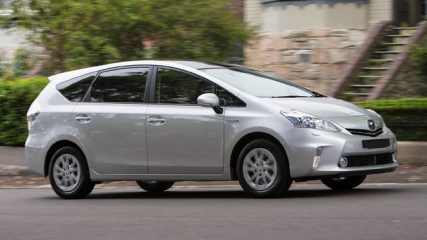Prius V 2012 Review
By Paul Pottinger · 22 May 2012
It's all too easy to poke fun at the Prius. And I should know. Having emptied the bile ducts over the years, however, it's probably only fair to dip one's lid in the direction of one of the most successful visual marketing exercises since the Coke bottle and Levis' 501s.The Prius is every bit as synonymous with hybrid cars as those other symbols are with soft drink and jeans. Except the Prius isn't cool. Oh, no. Never that.Nor is it especially practical, not in the way of the bigger, newer and actually very good Camry Hybrid, which now not only has boot space but can tow too. But then the Camry looks like a Camry, as opposed to an instantly recognisable advertisement for the eco virtue of those within.Which is where the Prius V comes in. The V denotes not "five", but stands for "versatile". Substantially bigger than the familar Prius, it seats seven. At least it has seven seats, enough to shift half the kid's footy or netball teams without making an outsize carbon footprint.VALUEAny form of seven-seater looks good at $35,990, the sticker price of the entry level V. It looks all the better for being only a grand over the standard Prius, though the top spec i-tech Prius is still wildly overpriced at $46K. Expect the V i-Tech to go over that when it arrives by year's end, replete with leather, sun roof, sat-nav and such like. The package at hand lacks for little, with fruit including display-screen, auto air-con, 16-inch alloys, head-up display, keyless entry and ignition and the now unavoidable daytime running lights.In a market otherwise almost burdened by choice, people movers are the only thing not found in abundance. This, of course, is the only hybrid. The V looks handsome against such rivals as there are, though Kia's hard-breathing Rondo starts under $30K as do a few SUVs with a third row of seats.Getting rid of it might prove difficult. As a number of private and fleet owners have found to their considerable cost, the used Prius market belongs to the buyer.TECHNOLOGYYou don't need me to expound yet again the almost miraculous fuel saving of the petrol/electric hybrid powertrain. Suffice, that under optimum conditions the combined 1.8-litre Atkinson cycle petrol engine and 60kW electric motor are capable of returning 4.4 litres of premium unleaded fuel per 100km. Only after a freeway stretch on our introductory drive did consumption rise, and then to a hardly outrageous 5.7.As with the Prius, there are three drive modes: EV allows for deathly-quiet running on electric motor power alone for up to 2km; Eco dampens throttle response and limits power consumption from the air-con; Power does what it suggests without scandalising Bob Brown. Unlike the Prius, the V model debuts a space-saving lithium-ion battery pack, which resides under the centre console between the two front pews. It's this which has made the third row of seating feasible.DESIGNEven without the aid of new battery gubbins, the Prius has been expanded damn cleverly. The V is substantially longer, wider, higher and heavier while remaining recogniseably of the now three model line up (including the tiny $24K Prius C).The seven-seat format consists of three independent sliding, reclining and split-folding second-row seats and a 50:50 split-folding third tier. Each row is elevated above that in front. With seven up there's 80 litres of cargo space, thrid row flat there's 485 or four full size golf bags. Don't know about full size adults in the back row, though. Despite claims to the contrary, it's kids only.SAFETYThough not yet crash tested, it's difficult to see the V failing to realise the number of ANCAP stars its model name implies.Kit includes seven airbags, reversing camera, hill-start assist, stability and traction control, and anti-skid brakes with brake assist and electronic brakeforce distribution. It's all there.DRIVINGWell, you can't have everything. At least you can't have your Prius with anything other than an utterly anodyne drive. You'll get a more involving experience on XBox. And comparable steering feel.Even with two on board, the V starts to labour on longer hills. When carrying seven, well ... be good to stay out of the overtaking lane, won't you? All of which is, of course, quite beside the point. No one's asking this to take corner quickly or even half capably, which is just as well.The V will, however, do precisely what it says on the tin, and that's move five and two half people prodigious distances between visits to the bowser. Clincially capable then.VERDICTIf the small and medium Prius strike you as a bit pointless, here's one that makes sense in practice as well as on paper.Toyota Prius VPrice: 35,990Warranty: 3 years/100,000kmResale: 52 per centService interval: 6 months/10,000kmSafety raing: UntestedEngine: 1.8-litre 4-cyl petrol/electric hybrid, 100kW Transmission: continuously variable auto Fuel economy: 4.4L/100km, 101g/km CO2 Dimensions: 4.6m (L), 1.8m (W), 1.6m (H) Weight: 1505kg Spare: Temporary

_0.jpg)





